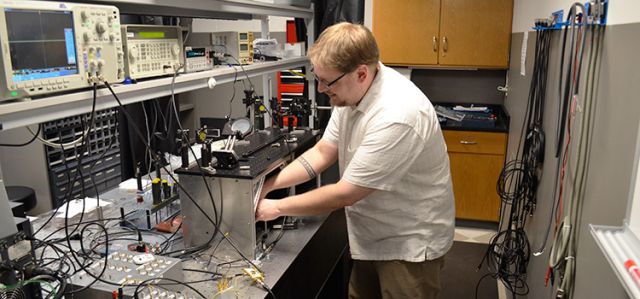Influence of Heterogeneous Refractivity on Optical Wave Propagation in Coastal Environments
Document Type
Article
Publication Date
12-2015
Publication Source
Meteorology and Atmospheric Physics
Abstract
Spatial variations of refractivity significantly dictate the characteristics of optical wave propagation through the atmosphere. Consequently, the ability to simulate such propagation is highly dependent upon the accurate characterization of refractivity along the propagation path. Unfortunately, the scarcity of high spatiotemporal resolution observational data has forced many past studies of optical wave propagation to assume horizontally homogeneous (HH) atmospheric conditions. However, the (adverse) impact of such an assumption has not been quantified in the literature.
In this paper, we attempt to fill this void by utilizing a mesoscale modeling-based approach to explicitly simulate atmospheric refraction. We then compare the differences of the HH refractivity fields to the mesoscale model-derived refractivity fields by means of a realistic atmospheric event and through ray tracing simulations. In this study, we model a coastal low-level jet, a common coastal atmospheric phenomenon which is associated with heterogeneous thermal and refractivity fields. Observational data from a radiosonde and a radar wind profiler near the northeastern region of the United States are used for model validation.
The observed characteristics of low-level jet (e.g., evolution, intensity, location) and associated temperature inversion are found to be reasonably well captured by the mesoscale model. The simulated nighttime refractivity gradient field manifests significant spatial heterogeneity; over land, the refractivity gradient is much stronger and amplified near the ground, whereas it becomes much weaker over the ocean. We quantify the effect of this heterogeneity on optical ray trajectories by simulating a suite of rays and documenting the variability of their altitudes at certain propagation ranges.
It is found that the altitude of optical rays may vary tens of meters during a diurnal cycle, and at nighttime the rays may bend downward by more than 150 m at a range of 100 km. We run additional ray tracing simulations using refractivity profiles from a single location and assuming HH refractivity along the propagation path. It is observed that the HH approach yields instantaneous ray bending magnitudes up to 30 % less than the ray bending based on the refractivity simulated by the mesoscale model. At the same time, it is found that the mesoscale model-based refractivity fields may have uncertainty introduced by different factors associated with the model configuration. Of these factors, turbulence parameterization is explored in-depth and found to be responsible for more uncertainty than spatial grid resolution. To be more specific, different turbulence parameterizations are found to produce significantly varying temperature inversion parameters (e.g., height, magnitude), which are critical factors influencing ray trajectories. Collectively, these results highlight the potential advantages and disadvantages of utilizing a mesoscale model to simulate refractivity in coastal areas as opposed to assuming HH refractivity.
Inclusive pages
685–699
ISBN/ISSN
0177-7971
Copyright
Copyright © 2015, Springer-Verlag Wien
Publisher
Springer-Verlag Wien
Volume
127
Issue
6
Peer Reviewed
yes
eCommons Citation
He, Ping; Nunalee, Christopher G.; Basu, Sukanta; Minet, Jean; Vorontsov, Mikhail; and Fiorino, Steven T., "Influence of Heterogeneous Refractivity on Optical Wave Propagation in Coastal Environments" (2015). Electro-Optics and Photonics Faculty Publications. 45.
https://ecommons.udayton.edu/eop_fac_pub/45
COinS




Comments
Permission documentation is on file.